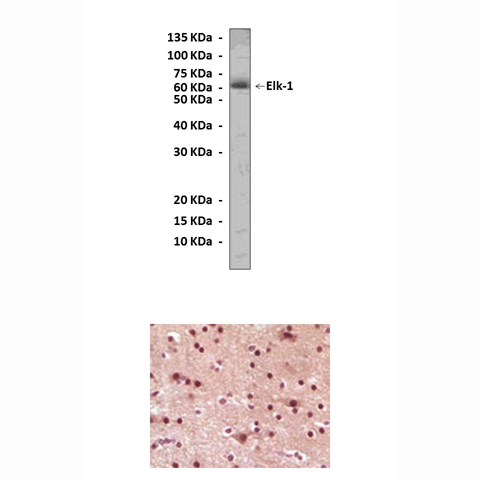Product Sheet CP10077
Description
BACKGROUND The ETS-domain transcription factor family can be divided into a series of subfamilies. Elk-1 represents the founding member of the ternary complex factor (TCF) subfamily, along with SAP1 and SAP2/Net. In addition to the characteristic ETS DNA-binding domain, TCF subfamily also contains a short protein interaction motif known as the B-box, which enables them to interact cooperatively with a second transcription factor SRF. The unique ability of the TCF proteins to bind to SRF is thought to confer distinctive promoter recognition specificity to these proteins. Several target genes have been identified for ELK-1. Proteins of the TCF subfamily form a ternary complex by binding to the serum response factor and the serum response element in the promoter of the target genes including c-fos proto-oncogene.1
Elk-1 is a nuclear target for the ras-raf-MAPK signaling cascade.2 Phosphorylation of Elk-1 by MAP kinases in the regulatory domain triggers a key series of events, leading from a conformational change to enhanced DNA binding, stimulation of its transcriptional activation properties and eventual triggering of the transcriptional repression activity of Elk-1. Phosphorylation-dependent recruitment of a co-activator might be also involved. The MAP kinase catalyzed phosphoylation occurred at a cluster of S/T motifs at its carboxyl terminus of Elk-1; phosphorylation at these sites, particularly Ser383, is critical for transcriptional activation by Elk-1.3 Elk-1 acts as a recipient of growth factor signals via the Ras/ERK pathway and transmits this into a change in gene expression profiles and hence affects cellular processes.
Elk-1 is a nuclear target for the ras-raf-MAPK signaling cascade.2 Phosphorylation of Elk-1 by MAP kinases in the regulatory domain triggers a key series of events, leading from a conformational change to enhanced DNA binding, stimulation of its transcriptional activation properties and eventual triggering of the transcriptional repression activity of Elk-1. Phosphorylation-dependent recruitment of a co-activator might be also involved. The MAP kinase catalyzed phosphoylation occurred at a cluster of S/T motifs at its carboxyl terminus of Elk-1; phosphorylation at these sites, particularly Ser383, is critical for transcriptional activation by Elk-1.3 Elk-1 acts as a recipient of growth factor signals via the Ras/ERK pathway and transmits this into a change in gene expression profiles and hence affects cellular processes.
REFERENCES
1. Sharrocks, A.D.:Biochem. Soci.Transact. 30:1–9, 2002
2. Sgambato, V. et al: J. Neurosci. 18:214-26, 1998
3. Yang, S. H. et al: EMBO J. 17:1740-9, 1998
2. Sgambato, V. et al: J. Neurosci. 18:214-26, 1998
3. Yang, S. H. et al: EMBO J. 17:1740-9, 1998
Products are for research use only. They are not intended for human, animal, or diagnostic applications.
Details
Cat.No.: | CP10077 |
Antigen: | Purified recombinant human Elk-1 fragment expressed in E. coli. |
Isotype: | Mouse IgG1 |
Species & predicted species cross- reactivity ( ): | Human |
Applications & Suggested starting dilutions:* | WB 1:1000 IP n/d IHC 1:100 - 1:200 ICC n/d FACS n/d |
Predicted Molecular Weight of protein: | 62 kDa |
Specificity/Sensitivity: | Detects endogenous Elk-1 proteins without cross-reactivity with other family members. |
Storage: | Store at -20°C, 4°C for frequent use. Avoid repeated freeze-thaw cycles. |
*Optimal working dilutions must be determined by end user.
Products
| Product | Size | CAT.# | Price | Quantity |
|---|---|---|---|---|
| Mouse Elk-1 Antibody: Mouse Elk-1 Antibody | Size: 100 ul | CAT.#: CP10077 | Price: $531.00 |

